Scientific Facts
| Common Name | American Bullfrog |
| Scientific Name | Lithobates catesbeianus |
| Life Span | 7 to 10 years |
| Size | 3.5 to 9 inches (adultfemale) |
| Habitat | Lakes,sloughs, reservoir, river, pond |
| Country of Origin | Neartic Region (from the eastern to the central U.S., north to Nova Scotia, and south to Mexico) |
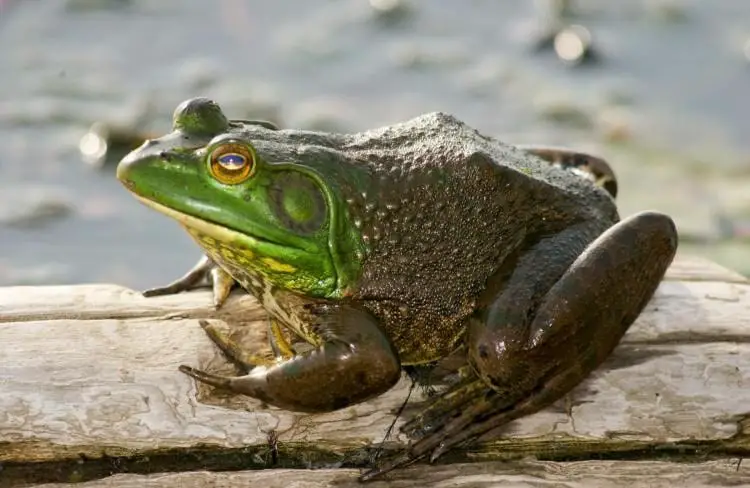
Physical Description
Considered as the largest true frog found in North America, the American Bullfrog can weigh up to 0.5 kilograms and can reach a length of up to 203 mm length. Length can range through 90 to 150 mm. Their color varies from green or greenish-brown. You can also find frogs that have light to dark shade color. Meanwhile, their back and side have plain to dark spots or blotches. The underparts are white and are mottled or spotted. Their legs and arms are spotted or barred with dark colors. The hind feet of these frogs are also webbed. They also have a very attractive iris which can vary from golden to reddish-bronze color. In addition, the head of these frogs are broad and flat and have a largemouth.
The physical description of male and female American Bullfrogs can differ. Most male frogs have a yellow-colored throat, especially during the breeding season. Meanwhile, female frogs have a white throat. Male frogs have large tympanums (a round circle located on the side of the head). Their tympanums are larger than their eye. Compared to male frogs, females can have tympanums that are either large or smaller than the eye.
American Bullfrogs are giants and can grow up to 9 inches. They are so large than even tadpoles can reach 6.75 inches in length. With big legs and webbed feet, these frogs are incredible swimmers. Although large in size, their body composition is actually low in fat and calories. Commonly found in sloughs, ponds, lakes, or reservoirs, you’ll immediately notice them just by hearing their calls. They have a deep and resonant baritone call which resembles a mooing bull or cow, hence its name. Male frogs can also produce a “jug-o-rum” bellow. You can hear these male choruses in both day and night. The maximum lifespan of these giant frogs is about 8 to 10 years and can live up to 15 years in captivity.
Life Span
It’s vital that the keeper provides the optimal environment for American Bullfrogs. They can thrive very well under captive conditions and can easily grow and develop. Understanding the life span of these frogs is critical if you want to ensure that they are able to breed. Their longevity in the wild can reach 8 to 10 years, and captive species can live for almost 16 years. Provide the proper environment, and you should be able to observe its incredible life cycle.
Spawning
During the intercourse, these frogs will exhibit amplexus position or also known as their intercourse position. This is where the male frog fertilizes the eggs which the females have laid. One female frog can lay up to 20,000 eggs in masses.
Eggs
The life of these frogs starts by the time the central yolk of the egg splits in to. After 6 to 20 days, the embryo will begin to look more and more like a tadpole. They start to move, and their length begins to extend. Usually, the number of zygotes sired by the male American Bullfrog ranges from 5000 to 60,000. This can lead to 300 to 30,000 resultant hatchlings.
Tadpoles
As mentioned earlier, American Bullfrog tadpoles can be pretty big compared to other frogs. It has a standard size of 80 to 150mm. They can take from 12 to 48 months to reach the metamorphosis stage. The bodies of these tadpoles can be as large as a golf ball and have a longer length. They have a muscular tail and have high fins. Colors range from brown to light olive. The black spots that are scattered across their head and their upper body are also noticeable.
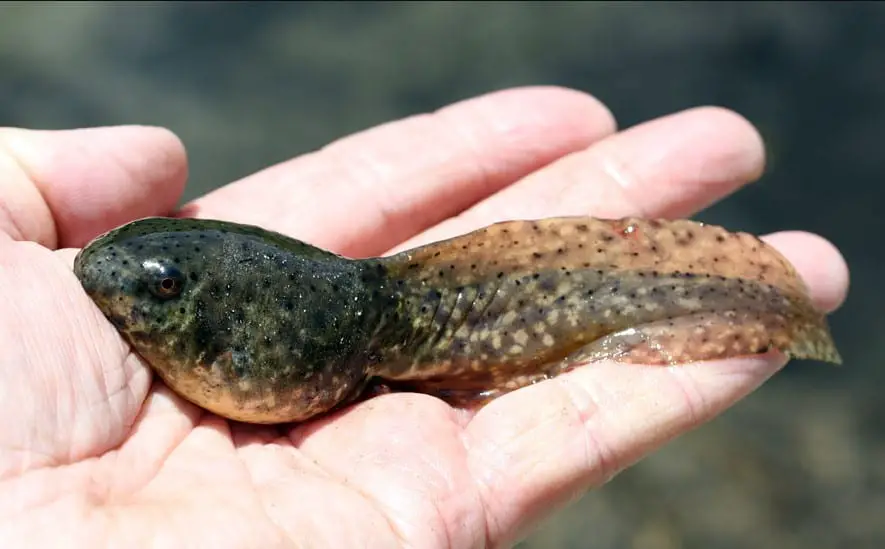
Metamorphosis
With the right condition, tadpoles can healthily metamorphose. Metamorphosis happens after a few months, but for some frogs, it can reach up to 3 years. There are factors involved when it comes to the larval period of American Bullfrogs, and this includes climate or temperature. During the metamorphosis stage, the tadpoles resorb their finned tails as well as their gills. They then begin transforming into juvenile miniatures of adult frogs. However, at this stage, they are still without secondary sexual characters.
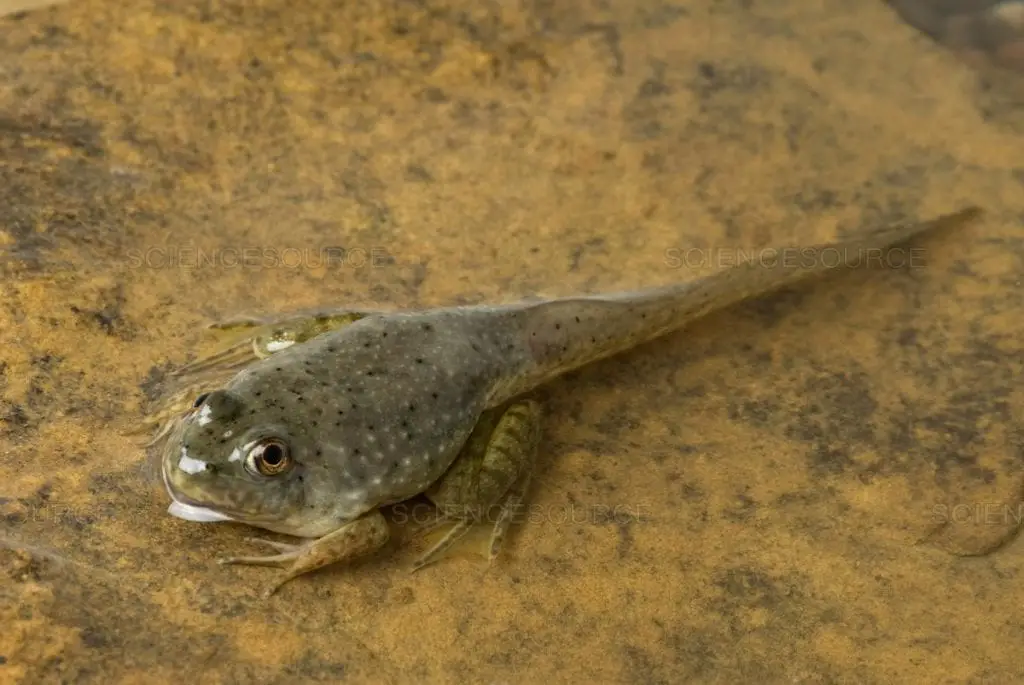
Adult
Adult frogs now have clearer or darker colors. Their colors vary from brown, green, and olive. You’ll also notice the vague blotches or spots on their body. The legs are banded and blotched while their heads have lighter green colors. Their hind feet are now fully webbed, and there are no dorsolateral folds – although there are short folds that extend from its eye over the past the eardrum to the forearm. Adult American Bullfrogs also have smoother skin.
Eating Habits
American Bullfrogs are considered as ambush predators. Most of their meals include insects, worms, snails, crustaceans, tadpoles, other frogs, aquatic eggs, salamanders, dragonfly, snails, crayfish, and snakes. There are also cases wherein these frogs eat bats. They are also cannibalistic in nature and will not hesitate to eat other American Bullfrogs. Although they are carnivores, they are also known to eat plant foods such as algae and tadpoles usually graze on aquatic plants.
These frogs are voracious eaters, and they lie in wait for their meal to pass close by. They have incredible hunting skills that involve rotating to face their prey and quickly bounces to approach. Leaping towards their prey in a snap and whacking its sticky tongue is one of their remarkable skills. After capturing their meals, they then swallow their prey as a whole.
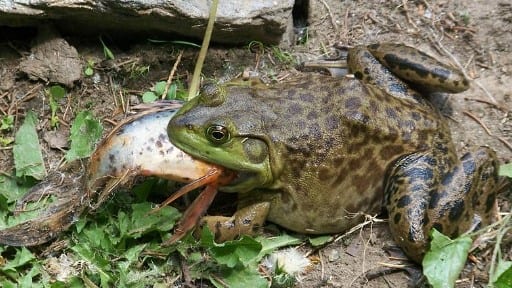
Sleeping Habits
You can find many animals in the wild that do not go into a state that fits the definition of sleep, and the American Bullfrog is one of them. However, although they don’t necessarily fall ‘asleep,’ they love to go into rests throughout the day. A study conducted back in the 1960s concluded that Lithobates catesbeianus do not go to sleep. Scientists and researchers have proven that both they and night, they don’t appear to be sleeping at all. Their responses during day and night are almost the same.
Development and Reproduction
Generally, American Bullfrogs are solitary animals, except when mating or during the breeding seasons which starts late May and into July. During the early summer, these frogs gather at the breeding ponds, which is much later than most native frogs that you’ll find in the wild. Males stay on the egg-laying sites and defend the perimeter. To attract female frogs, they begin making loud sounds. This loud calling has a dual purpose, one is to invite female frogs, and the other is to chase away rival female.
The mating system of these frogs is polygamous and fertilization usually (although not always) by one male. Females can deposit or lay masses of up to 20,000 eggs. The tadpoles hatch out and begin to emerge about 3 to 5 days after fertilization. These tadpoles usually hatch out in July and remain in the ponds through the summer and the following winter. The metamorphosis stage beings in August or September, which is the second year.
American Bullfrogs only breed once a year. The sexual age range or reproductive maturity of both male and female ranges from 3 to 5 years. Bullfrogs love breeding in the shallows where it has rich vegetation. They are highly territorial and male frogs defend circular territories that have 2 to 5 diameters. The definite their sites aggressively by biting, shoving, and pushing any rival males. When two males encounter, they settle in physical encounters. Larger males usually win since they are more powerful when it comes to pouncing, shoving, and wrestling.
Females choose their mate by entering the male’s territory. Male frogs who are older are usually picked by the female, as well as those that are larger in size. There are times when female vocalizes within male choruses in order to motivate and encourage male competition. The goal of the female frogs is to pick high-quality males only. After the female chooses the best male, the mating process begins.
As mentioned earlier, the fertilization of American Bullfrogs is external. After the mating amplexus or sex grasp, the male rides on top of the female. He grasps her with his forelimbs posterior to the female’s forelimbs. The female then starts depositing her eggs in the water while the male simultaneously releases the sperm.
How to Breed
If you’re contemplating breeding American Bullfrog, then it’s necessary that you consider several factors first. It’s crucial that you provide a breeding environment that is close to the natural seasonal cycle of your frogs. Captive breeding requires replicating their natural habitat. You must ensure that you control the temperature of the cage or terrarium. It should gradually become cold enough for your frogs to hibernate. It’s also necessary that you feed your frogs regularly. Simulating the rainy spring season is also essential when preparing your frogs to breed. This is when the male frogs begin to call the females.
What’s great about breeding American Bullfrogs is that it can be done in both indoors and outdoors. It can also be done all year round provided that you have mimicked their natural habitat. Here are some useful tips and guidelines that you can follow in order to successfully breed American Bullfrogs.
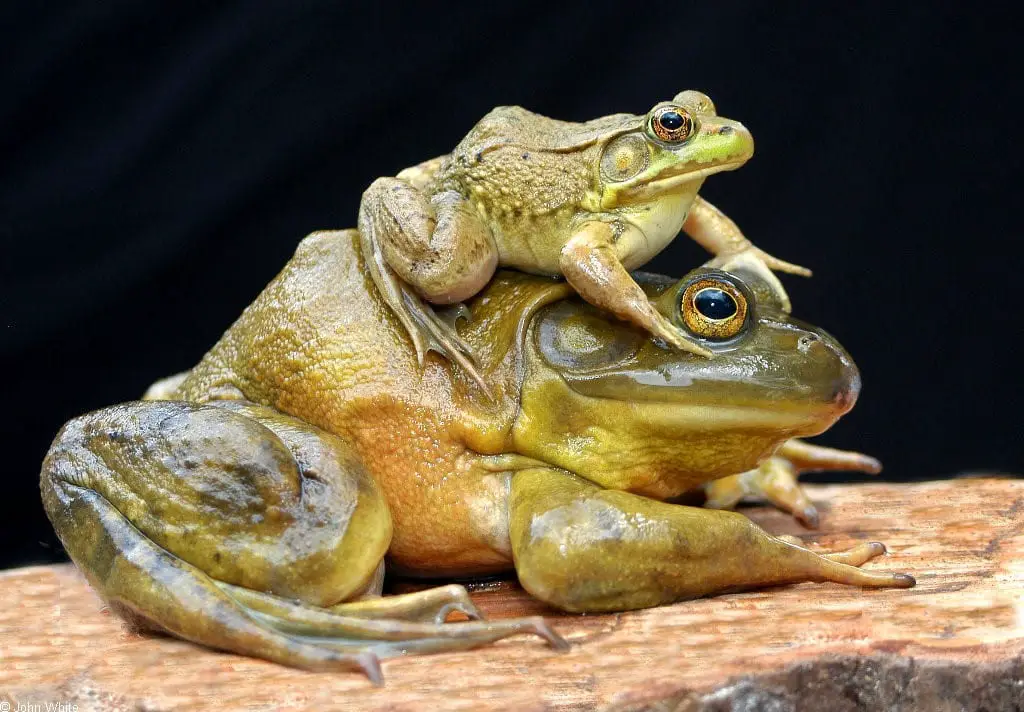
Research Regulations for Keeping, Raising, and Breeding Frogs in Your Area
First of all, you want to ensure that your breeding project is legal. There are states and countries that prohibit the collecting and raising of frogs. Like for instance, in Australia, you need to have a free permit in order to collect keep and collect tadpoles. When in doubt, always ask your local conservation department.
Create a Breeding-Friendly Habitat
It’s essential that you create a habitat that is conducive for breeding or mating. You can use an aquarium, cage, or a terrarium. There’s no need for you to provide deep water. Be sure that you only use de-chlorinated water – avoid using tap water. Bear in mind that female frogs will lay their eggs on the water, so you have to make sure that the water is clean. You can also provide natural food for the tadpoles such as tiny plants matter and algae.
You have to manipulate the environment to induce readiness for breeding. They breed seasonally in order to give the tadpoles and juvenile frogs the summer to grow and develop. This is where you’re going to need light and temperature manipulating. Also, you have to make sure that you check the health of your frogs before you breed.
Determining the Sex of the Frogs
This is quite obvious, but you really have to be 100% sure first that you are breeding male and female frogs. Remember that these frogs can be very aggressive and cannibalistic. You have to determine the sex of the frogs first, and there are various ways that you can employ in order to determine the sex of the frogs. It’s recommended that you have a group of frogs that contains more males than females. Keep in mind that female frogs are larger than males. Males also vocalize deeper and more resonant sounds.
Place the Breed Together
Once the habitat is ready, and you’ve chosen the best male and female frog, the next thing you need to do is place them together. Learn how to recognize the breeding readiness of the male and female. Try to check if the female has swelling bellies since this indicates that they already have eggs. You should also notice that the male vocalizes more frequently. Move them into a “rain chamber” where you’re going to mimic the wet season or rainy forest setting. There are breeders out there that provide overhead hose in order to provide falling water. Also, then forget to add some leaves or plants.
Return the Frogs to their Usual Home
Once the eggs have been laid, and the male was able to fertilize it, you will then have to return your adult frogs to their usual home or terrarium. Keeping them inside the same cage with the eggs can be disastrous. American Bullfrogs won’t hesitate to eat their eggs. After separating the eggs and the adults, the next thing that you need to do is to provide the best environment for the eggs to develop into tadpoles.
Taking Care of Tadpoles
It’s recommended that you feed the tadpoles with fish food that are finely ground. You also have to make sure that you maintain clean and healthy water quality. Tadpoles also love climbing out to air once they become juvenile frogs. Cover the cage or terrarium with a screen to prevent the tadpoles from climbing out. You can feed the baby frogs with small crickets or wingless fruit flies. Also, don’t forget to keep the frogs all the time. They may die if they become dehydrated. Adjust the setting of the habitat in order to accommodate baby frogs.
Common Health Problems
Even though American Bullfrogs are resilient, it’s still possible that they obtain diseases and some health issues in captivity. Failing to provide them a clean and healthy environment can make them sick. Of course, there are also factors that affect the health and growth of your frogs, such as genetics. Here are some of the most common health problems that are associated with American Bullfrog.
Bacterial Diseases
Just like any other amphibians that are maintained in captivity, American Bullfrogs are prone to bacterial diseases. Usually, bacterial diseases or infections are consequences of other problems such as unhygienic captive situations, traumatic injury, and myotic skin infections such as chytridiomycosis and saprolegniasis. To prevent bacterial diseases, it’s very important that you provide a safe, clean, and frog-friendly habitat for them.
Viral Diseases
Although there are few described pathogenic viruses that can affect American Bullfrogs, it’s still a concern for captive pets. Viral diseases can happen when you introduce new frogs to your collection, especially if they are from the wild. To prevent this, you have to make sure that you only buy frogs that came from reliable and reputable resources. If you’re introducing new frogs to your collection, then make sure that you check their health first. Try to observe whether or not the new frog is weak or healthy. It’s recommended that you quarantine your new pet. It’s also very important that you check the health of both the male and new frogs before you start breeding them.
Protozoan Parasites
Another common health problems that you need to watch out when keeping American Bullfrogs are the protozoan parasites. These organisms can affect both wild and captive frogs. Some protozoa don’t induce diseases, but there are also those that are considered as a treat to the amphibians. Again, check for signs and symptoms. If your frog has lesions or wounds, then make sure that you treat it as soon as possible.
Dehydration
We mentioned earlier that your frogs need to be moist all the time. Dehydration can happen to them if the habitat or the environment is too dry. This is why it’s crucial that you provide the right habitat and that you keep it moist. Dehydration can lead to respiratory difficulties and can be life-threatening.
Gas Bubble Disease
You should also watch out for Gas Bubble Disease, and signs include skin ulcers, hemorrhage, lethargy, and increased positive buoyancy. This is another life-threatening disease that you need to watch out when keeping American Bullfrogs. One of the leading cause of Gas Bubble Diseases is unintentional over aeration or supersaturation of the water.
Chemical Toxicity
Due to the high permeability of the frog’s skin, they are very susceptible to chemical toxicity. This is a common health problem that can affect both wild and captive frogs. Contaminated water is usually the cause of such toxicity. This leads to malformation, debilitation, and even death of tadpoles. You have to watch out for build-up of nitrogenous waste products such as nitrites and ammonia since this can be very lethal for the frogs. Conducting water quality testing is smart if you want to ensure that your frogs are healthy. Also, be sure that you wash your hands before and after holding your frogs. This prevents harmful chemicals from entering into your frog’s skin.
Nutrient Deficiency
Improper feeding can lead to nutrient deficiency. You have to ensure that you properly feed your frogs. There are also vitamins and minerals that you can purchase in the market today to boost their health – although feeding them with high-protein meals is also enough. You should also watch out for overfeeding since this can also affect the health of your frogs.
Preventing Illnesses
The first step of preventing theses illnesses and diseases is to ensure that your frogs have a clean and healthy habitat. You should provide them a stress-free environment that is free from any harmful bacteria and viruses. It’s also important that you always check for any unhealthy signs , prevent and find treatment before the illness worsen. Maintaining high-quality water is also essential to ensure that your frogs remain healthy. Frequently change the water. Also, don’t forget to feed them with the right meals. Watch out for the number of meals that you’re feeding them.
If you think that your frog has become very weak and lethargic, then the best thing that you can do is to go to your nearest veterinarian. Of course, you have to make sure first that the vet has adequate experience when it comes to checking and treating amphibians. Try to do online research first and don’t hesitate to call them. Ask them about their experience and background history when it comes to handling American Bullfrogs.
Behavior
Adult American Bullfrogs are great jumpers. They can leap about 3 feet or 1 meter. They are also able to jump for about 6 feet or 2 meters without any difficulty. These frogs are known to produce loud calls or vocalization, especially the male ones. They do this in order to establish their territories and at the same time, attract females. They can also be very aggressive when it comes to defending their territory.
These frogs are also nocturnal predators, and they are able to eat just about anything that can fit in their wide mouths. They sit and wait for their prey to come and then lunge with their powerful hind legs. Adult male frogs are known to be very aggressive, and once they encounter a rival, they settle by physically wrestling and pouncing each other.
It’s also worth knowing that these frogs prefer warm weather and hibernates during the cold season. They also bury themselves in the mud during cold seasons or find a small cave-like structure. Their key behaviors include territorial, sedentary, motile, diurnal, nocturnal, and hibernation.
Habitat
To provide proper care to these frogs, you have to ensure that you create a habitat that mimics their natural environment. American Bullfrogs are native to the Nearctic region and are found from Nova Scotia to Central Florida. You can also find them across the Great Plains to the Rockies and from East Coast to Wisconsin. And since they require water in order to live and thrive, they are usually found near bodies of water such as a bog, river, lake, or pond. They prefer shallow, still, and warm waters. These frogs also love waters that are rich in aquatic vegetation.
Bullfrogs are highly adaptable. Introduced in parts of Europe and the United States, these frogs were able to adapt in different environment and settings. However, in some areas of the world, these frogs have become a major pest problem. They are threatening native frogs and other species through competition and predation. These frogs have wide mouths and can feed to almost anything they can swallow. These frogs are also opportunistic feeders. They virtually eat almost anything. They feed on large preys which include fishes, birds, mammals, and other frogs.
Considered as one of the most prolific amphibians, American Bullfrogs can lay up to 12,000 to 12,000 eggs. They usually breed during the spring and summer seasons and can mate in both permanent and semi-permanent body of water. You can hear them producing booming sounds such as “jug-o-rum” or “roo-roo-room.” These calls are often heard from April through August. Also, if these frogs get startled, they being to shriek and alarm call and then leap into the water. You can also observe a spitting “phfft” from the males as an “aggression.” Here is some helpful information when preparing the habitat of American Bullfrogs.
Housing
Captive American Bullfrogs need to be more acclimatized to their captivity. It’s smart to find out more information about how they live in the wild in order to provide optimal habitat condition. These frogs spend almost their lifetime living near the edge of permanent and semi-permanent waters. You have to replicate marshes, swamps, lakes, or ponds.
You can keep these frogs in a large pond but make sure that you enclose it to avoid any animal escape. But if you chose to take care of them indoors, then you have to have a glass enclosure or a terrarium that has a length of about 36 inches to 18 inches and has the 55-gallon capacity. When it comes to keeping American Bullfrogs, the larger the housing is, the better. These species need a lot of space since they love to jump. You can also put up visual barriers to avoid any injuries.
It’s also recommended that you provide these frogs a hiding spot. Creating a few basking areas is also healthy for them as well as good bedding. It’s also a great idea to give them a large aquatic section inside the enclosure. Make sure that the water is deep enough that the frog can be completely submerged. Include some vegetation in the water as well. It’s healthy that you only use tap or spring water and avoid chlorinated water. Keep in mind that using distilled water can be very harmful to your frog’s health.
Always clean the closure every day and get rid of droppings daily. Refresh the water a couple of times a week, and general cleaning should be performed no less than once a month. Some keeper uses a filter with a mild current in the water, however, bullfrogs are happier in stiller waters.
Lighting and Temperature
American Bullfrogs require a temperature gradient to control or regulate their body temperature. This means that they need to have a spot inside the enclosure where they can cool down or warm-up. Divide the aquarium or terrarium into two parts. One side for the cool side and the other for all heat elements. The frogs will start moving back and forth from these two different spots, depending on their needs.
The warm side of the enclosure should be between 75 to 85 degrees, and the rest of the enclosure should be near normal room temperature – around 74 degrees. Buying thermometer in order to monitor the temperature inside the enclosure is recommended. If you wanted to increase the heat inside the tank or enclosure, using an under-tank heat pad is advisable. Also, be sure that you use 2.0 UVB bulb in order to provide necessary ultraviolet rays for your pet.
When it comes to lighting, the requirements depend on what temperature you have inside the house. The perfect room temperature should not drop below 75 degrees Fahrenheit. If you think that your frog is not very active or is losing appetite, then it’s a good idea to increase the temperature in order to create a warmer home or enclosure. Humidity is also important when caring for your amphibian pets. They require a damp tank and plenty of water for them to swim in. adding smooth and small rocks inside the enclosure is also recommended. There are also keepers who add dirt inside the container since these bullfrogs love to burrow.
Substrate
You can use cocoa fiber as a substrate for your frog enclosure. It’s made from coconut husks and is a recommended organic option for a substrate. When we say substrate, this means the bedding that lines the bullfrog’s enclosure. And aside from coco fiber, you can also use peat moss. Your goal is to look for a substrate that is able to retain heat.
It’s also essential that you avoid any soil or substrate that has been treated with chemicals or insecticides. Be sure that you maintain the cleanliness inside the enclosure. Clean and change it frequently. You need to know that bullfrogs also eat the substrate inside the enclosure, and so make sure that they are highly digestible.
Food and Water
Providing your frogs with the right amount of water and a healthy diet is crucial to their growth and development. You can feed them with insects, mealworms, crickets, and small rodents. Although they are carnivores, you have to make sure that you avoid feeding them with grocery store meat such as beef and chicken. They are voracious eaters, and they easily get attracted to moving preys.
When feeding your frogs, it’s smart that you don’t feed them with your hand since they have a very strong jaw grip and their bite can be very nasty. Using a food dish when feeding or using tongs is a good practice. Feeding them occasional mouse is also a great idea but make sure that you don’t overfeed them. Juvenile frogs can be fed every day, but adults need to be fed every other day. Don’t forget to dust their food with calcium a few times affect. Adding a vitamin supplement can also boost their growth and development.
How to Care for an American Bullfrog?
American Bullfrogs can live inside your pond or inside your home – using an enclosure or terrarium. Before you keep your frogs inside your home. You have to make sure first that you build them or provide them an appropriate tank or enclosure. As much as possible, the tank should be large and have plenty of space where they can move around, feed, burrow, jump, leap, and sit.
You should also make sure that you fill the enclosure with necessary materials or items such as rocks, gravel, plants, soil, substrate, and pond water. This creates an almost natural frog environment. Be sure that the frog tank or enclosure has a wet area. Moreover, you should also make sure that you add plenty of hiding spots inside the enclosure.
Don’t hesitate to invest the appropriate equipment for your tank. Purchasing a high-quality filter for your frog’s tank is also recommended. You can also purchase a heater if you live in a colder environment. Also, never forget to clean your bullfrog’s home from time to time. You can use aquarium forceps in order to get rid of the leftover food or frog feces. Also, don’t forget to replenish the water supply regularly.
Also, if this is your first time taking care of American Bullfrogs, then it’s smart that you do some research first. If you have friends or families who have kept and bred these species before, then don’t hesitate to ask for tips, guidelines, and recommendations from them.
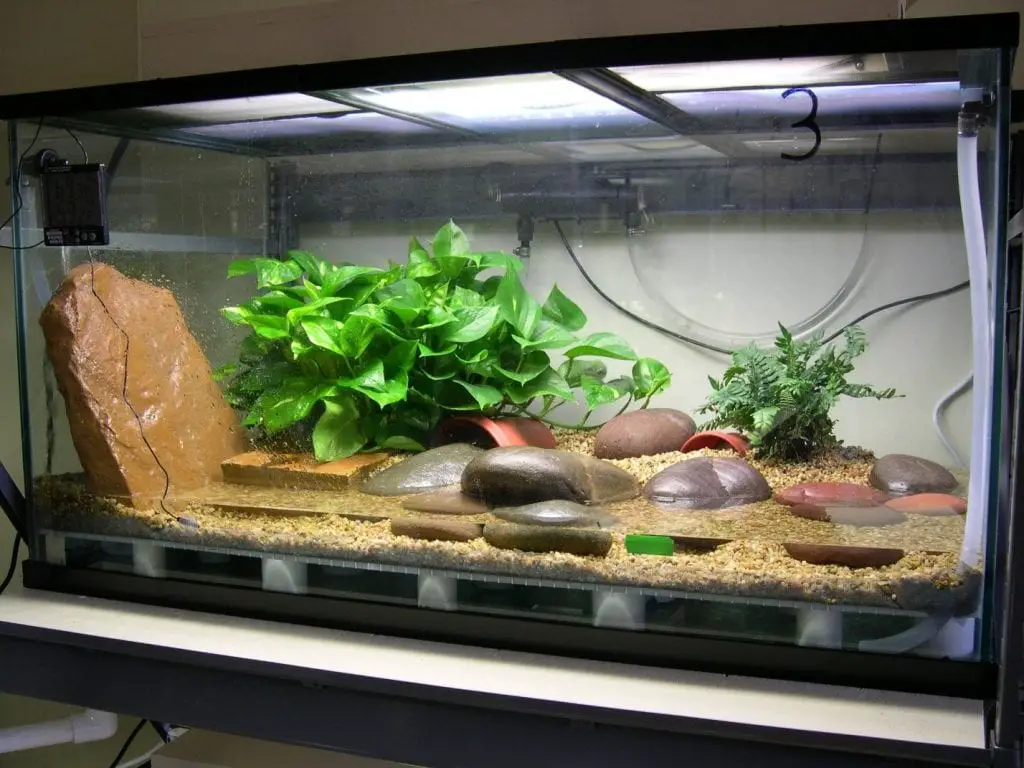
Where to Get One?
You can catch them on ponds or shallow waters, or you can also buy them online such as Underground Reptiles (undergroundreptiles.com) and Backwater Reptiles (backwaterreptiles.com)
FAQs
How much do you feed an American Bullfrog?
Feeding bullfrogs with live invertebrates such as crickets, mealworms, or earthworms are healthy. They are voracious predators and will feed too much given the opportunity. Adults should be fed 2 to 3 times a week while juvenile frogs can be fed every couple of days.
What do tadpoles eat?
Tadpoles can eat aquatic plants, insects, and algae.
Do American Bullfrogs need water?
Yes. In fact, most of their lives in the wild are spent living near water areas such as boog, rivers, pond, lake. They love still, shallow, and warm waters.
Are they good pets?
If you are fond of decorative pond or terrarium inside your home, then yes. American Bullfrogs can be an amusing family pet, and they have attractive colors that vary from grayish brown to the olive green base color. Their bellies are yellowish and are off-white.
Do American Bullfrogs need heat lamps?
It’s advisable that you provide your frogs with plenty of hiding areas inside the enclosure as well as basking spots. Heat lamps are not necessary, although they can be very useful when it comes to adjusting or regulating the temperature.
How long can these frogs go without eating?
They can live without eating for about half a week up to 2 weeks.
Do they hibernate?
Yes, they hibernate in aquatic settings. Also, they are capable of breathing both via their skin and lungs. When hibernating, they do the breathing via their skin.
What’s the main difference between male and female frogs?
Female frogs are larger inside, and male heads are narrower. The through of the male bullfrog is color yellow while the female is white.
How long does it take for their tadpoles to become frogs?
This depends on their environment or habitat. But naturally, the tadpole state can last as long as 8 months. Although there are cases wherein it only took 6 to 9 weeks.
Will frogs eat my pond fish?
Yes. Anything that can fit inside their mouth and anything that moves is a delicious meal for them.
Do bullfrogs sleep?
No. They are one of those animals that don’t need sleep. Although they require rest.
What eats American Bullfrogs?
These giants are also eaten by different animals, depending on the region. Predators include great egrets, great blue herons, herons, raccoons, turtles, snakes, and kingfishers.
How do bullfrogs interact with humans?
They are used by some governments to control insect pests. They are also very important in the medical and research field because of their digestive, muscle, skeletal, and nervous systems.
Do they cause problems?
In some areas in the world, bullfrogs are considered as pests. They are large and have a voracious appetite which outcompetes the prey upon many indigenous species.


